高中英语人教版必修3教案:Unit 5 Period 7 Revision Summing up and learning tip
- 格式:doc
- 大小:75.50 KB
- 文档页数:6
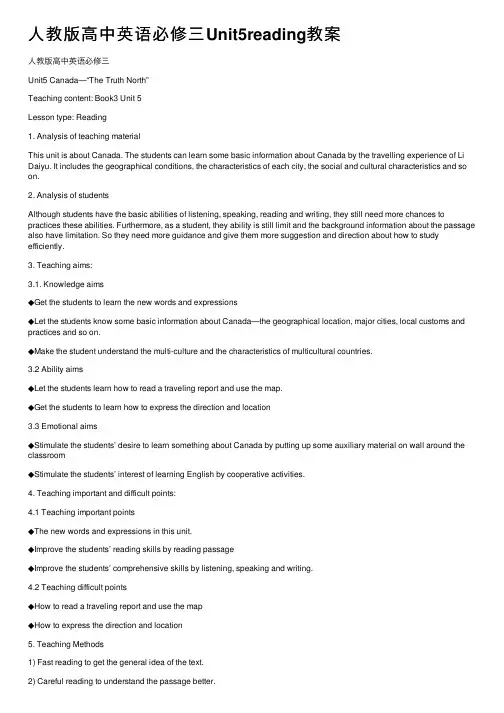
⼈教版⾼中英语必修三Unit5reading教案⼈教版⾼中英语必修三Unit5 Canada—“The Truth North”Teaching content: Book3 Unit 5Lesson type: Reading1. Analysis of teaching materialThis unit is about Canada. The students can learn some basic information about Canada by the travelling experience of Li Daiyu. It includes the geographical conditions, the characteristics of each city, the social and cultural characteristics and so on.2. Analysis of studentsAlthough students have the basic abilities of listening, speaking, reading and writing, they still need more chances to practices these abilities. Furthermore, as a student, they ability is still limit and the background information about the passage also have limitation. So they need more guidance and give them more suggestion and direction about how to study efficiently.3. Teaching aims:3.1. Knowledge aims◆Get the students to learn the new words and expressions◆Let the students know some basic information about Canada—the geographical location, major cities, local customs and practices and so on.◆Make the student understand the multi-culture and the characteristics of multicultural countries.3.2 Ability aims◆Let the students learn how to read a traveling report and use the map.◆Get the students to learn how to express the direction and location3.3 Emotional aims◆Stimulate the students’ desire to learn something about Canada by putting up some auxiliary material on wall around the classroom◆Stimulate the students’ interest of learning English by cooperative activities.4. Teaching important and difficult points:4.1 Teaching important points◆The new words and expressions in this unit.◆Improve the students’ reading skills by reading passage◆Improve the students’ comprehensive skills by listening, speaking and writing.4.2 Teaching difficult points◆How to read a traveling report and use the map◆How to express the direction and location5. Teaching Methods1) Fast reading to get the general idea of the text.2) Careful reading to understand the passage better.3) Discussion to help the students understand better what they’ve learned and to use the knowledge they’ve learned in this period.。
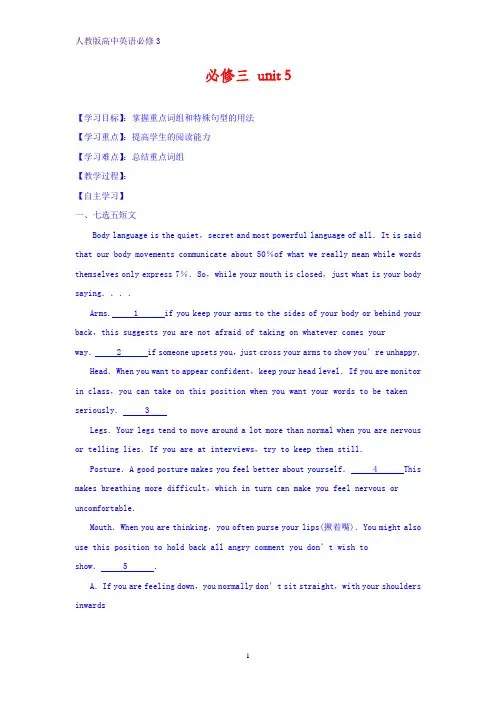
必修三unit 5【学习目标】:掌握重点词组和特殊句型的用法【学习重点】:提高学生的阅读能力【学习难点】:总结重点词组【教学过程】:【自主学习】一、七选五短文Body language is the quiet,secret and most powerful language of all.It is said that our body movements communicate about 50%of what we really mean while words themselves only express 7%.So,while your mouth is closed,just what is your body saying....Arms. 1 if you keep your arms to the sides of your body or behind your back,this suggests you are not afraid of taking on whatever comes your way. 2 if someone upsets you,just cross your arms to show you’re unhappy.Head.When you want to appear confident,keep your head level.If you are monitor in class,you can take on this position when you want your words to be taken seriously. 3Legs.Your legs tend to move around a lot more than normal when you are nervous or telling lies.If you are at interviews,try to keep them still.Posture.A good posture makes you feel better about yourself. 4 This makes breathing more difficult,which in turn can make you feel nervous or uncomfortable.Mouth.When you are thinking,you often purse your lips(撅着嘴).You might also use this position to hold back all angry comment you don’t wish toshow. 5 .A.If you are feeling down,you normally don’t sit straight,with your shoulders inwardsB.If you are pleased,your usually open your eyes wide and people can notice this.C.Outgoing people generally use their arms with big movements,while quieter people keep them close to their bodies.D.How you hold your arms shows how open and receptive you are to people you meet.E.However,it will probably still be noticed,and people will know you’re not pleased.F.However,to be friendly in listening or speaking,you must move your head a little to one side.G.Don’t say too much when you’re happy.二、阅读型完型One of my father's favorite 1 (say) as I was growing up was “Try it!”I couldn't say I didn't like something, 2 it might be, until after I tried it. Over the years I've come to realize how much of my success I owe tomy 3 (accept) of those words as one of my values. My first job was just oneI decided to try for a couple of years until I determined what I wanted to do asa career (职业). 4 (actual) I believed I would work for a few years,get 5 (marry), stay home and raise a family, so I didn't think the job I took mattered that much. I couldn't 6 more mistaken. I mastered the skills of that 7 (begin) level position and I was given the opportunity (机会) to move up through the company into 8 (differ) positions. I accepted each new opportunity with the thought, “Well, I'll try it; 9 I don't like it I can always go back to my 10 (early) position.” But I was with the same company for the past 28 years.1 2 3 4 56 7 8 9 10二、短文改错It is important to do with the rubbish in cities. Rubbish must be 1.________ treated properly. Thus, it may cause a lot of problems. It may pollute 2._________ the air and water. When people breathe the polluted air or drink polluted 3_________ water, we may get ill. Our city has begun to pay attention to the problem.4._____ As far as I know, some rubbish is sorted and sent to different factory. 5._________ Rubbish, such as old newspapers and glass, are recycled. Some harmful 6._________ rubbish is sent to a certain place and buried. Waste air is cleaned after it7._____ goes into the air. Waste water is treated before it poured into rivers. To 8._________ protect from the environment, the government has passed laws to 9.________ prevent people from throwing rubbish everywhere. We should do our 10._______ best to take good care of the environment and fight against pollution.。
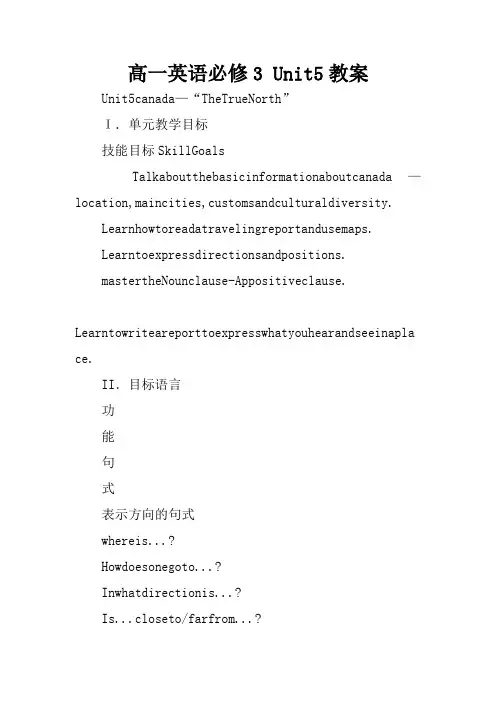
高一英语必修3 Unit5教案Unit5canada—“TheTrueNorth”I.单元教学目标技能目标SkillGoalsTalkaboutthebasicinformationaboutcanada—location,maincities,customsandculturaldiversity.Learnhowtoreadatravelingreportandusemaps.Learntoexpressdirectionsandpositions.mastertheNounclause-Appositiveclause.Learntowriteareporttoexpresswhatyouhearandseeinapla ce.II.目标语言功能句式表示方向的句式whereis...?Howdoesonegoto...?Inwhatdirectionis...?Is...closeto/farfrom...?Howfaris...?表示位置的句式Itis/liesinthenorth/southof...Itis/liestothesouth/east/northwestof...Itiswithin...kilometersof...Itis/liesonthewest/east.Theplaceisontheborder.yougoalongthecoast.Itiseast/westof...Itisfarawayfrom...onegoesnorthward.词汇.四会词汇Quizcanadianministercontinentbaggagechatsceneryeast wardwestwardupwardsurroundharbormeasureaboardeaglew ithinborderslightacreurbantopicmixmixturebushmaplef rostconfirmwealthydistancemistmistyschoolmateboothd owntownapproximatelydawnbuffetbroadnearbytraditiont errifyterrifiedpleasedimpressimpressive2.词组Primeminister,ratherthan,settledown,managetodo,catc hsightof,haveagiftfor,inthedistance语法NounclauseastheappositiveIII.教材分析与教材重组.教材分析本单元通过两位女孩李黛玉与刘茜的加拿大之旅,向我们展示了加拿大的一些基本概况,包括它的地理位置、主要城市、风土人情以及它的多元文化。
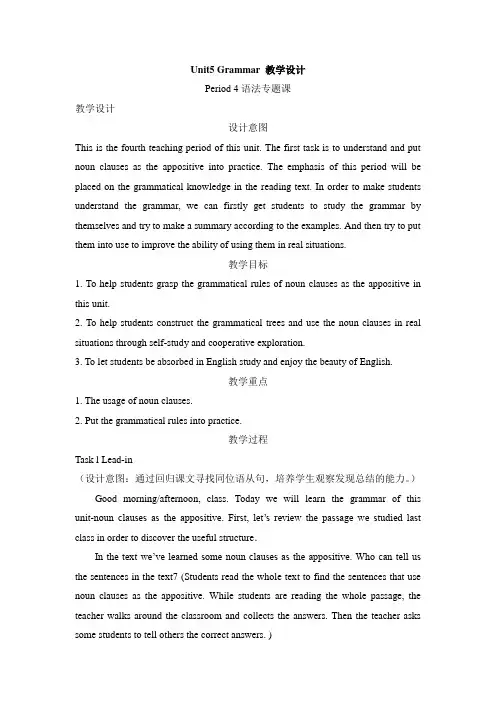
Unit5 Grammar 教学设计Period 4语法专题课教学设计设计意图This is the fourth teaching period of this unit. The first task is to understand and put noun clauses as the appositive into practice. The emphasis of this period will be placed on the grammatical knowledge in the reading text. In order to make students understand the grammar, we can firstly get students to study the grammar by themselves and try to make a summary according to the examples. And then try to put them into use to improve the ability of using them in real situations.教学目标1. To help students grasp the grammatical rules of noun clauses as the appositive in this unit.2. To help students construct the grammatical trees and use the noun clauses in real situations through self-study and cooperative exploration.3. To let students be absorbed in English study and enjoy the beauty of English.教学重点1. The usage of noun clauses.2. Put the grammatical rules into practice.教学过程Task l Lead-in(设计意图:通过回归课文寻找同位语从句,培养学生观察发现总结的能力。
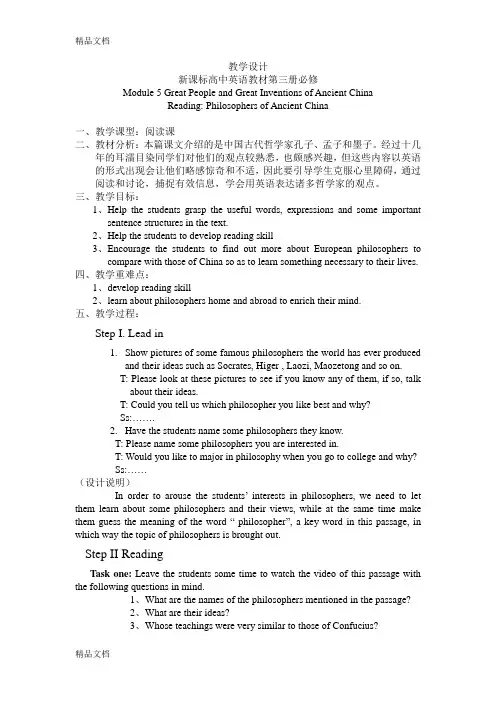
教学设计新课标高中英语教材第三册必修Module 5 Great People and Great Inventions of Ancient ChinaReading: Philosophers of Ancient China一、教学课型:阅读课二、教材分析:本篇课文介绍的是中国古代哲学家孔子、孟子和墨子。
经过十几年的耳濡目染同学们对他们的观点较熟悉,也颇感兴趣,但这些内容以英语的形式出现会让他们略感惊奇和不适,因此要引导学生克服心里障碍,通过阅读和讨论,捕捉有效信息,学会用英语表达诸多哲学家的观点。
三、教学目标:1、Help the students grasp the useful words, expressions and some importantsentence structures in the text.2、Help the students to develop reading skill3、Encourage the students to find out more about European philosophers tocompare with those of China so as to learn something necessary to their lives.四、教学重难点:1、develop reading skill2、learn about philosophers home and abroad to enrich their mind.五、教学过程:Step I. Lead in1.Show pictures of some famous philosophers the world has ever producedand their ideas such as Socrates, Higer , Laozi, Maozetong and so on.T: Please look at these pictures to see if you know any of them, if so, talkabout their ideas.T: Could you tell us which philosopher you like best and why?Ss:…….2.Have the students name some philosophers they know.T: Please name some philosophers you are interested in.T: Would you like to major in philosophy when you go to college and why?Ss:……(设计说明)In order to arouse the students’interests in philosophers, we need to let them learn about some philosophers and their views, while at the same time make them guess the meaning of the word “ philosopher”, a key word in this passage, in which way the topic of philosophers is brought out.Step II ReadingTask one: Leave the students some time to watch the video of this passage with the following questions in mind.1、What are the names of the philosophers mentioned in the passage?2、What are their ideas?3、Whose teachings were very similar to those of Confucius?4、Why did Mencius resigned?5、What is the difference between the views of Confucius and that ofMozi?T: Now I ’like you to watch the video with some questions in mind to get a general idea of the whole passage.Ss:……….(设计说明)In learning a foreign language, listening should come before reading, especially for high school students who have no time to communicate with foreigners, and with some questions in mind while listening is helpful for them to grasp the main idea of the passage and avoid blind listening.Task two:Skimming1.Leave the students five minutes to skim the passage and pick out the topics sentences of each paragraphT. Now that you have got some idea about these philosophers, next go over the text quickly to pick out the topic sentences of each paragraph.2.Show the topic sentences on the computer screen(1)Confucius is the philosopher whose influence has been the greatest.(2)Mencius was a thinker whose teachings were very similar to those ofConfucius.(3)Mozi founded the philosophy called Mohism.(设计说明)Going through the passage quickly to find the topic sentences is to help them improve their reading skill and in the long run to learn writing.Task three:Scanning: Let the students read the passage more carefully and finish the following exercise.T: Please read the text in detail this time and then carry out the following activities.1. fill in the blanks without looking at your books, each blank with one word.(1)Confucius is the ________whose influence has been the greatest.(2)Confucius ________the importance of kindness.(3)Mencius was a thinker whose _______were very similar to those ofConfucius.(4)However, when he saw that the ruler was not following his advice, he_______.(5)Mozi was another teacher who was very _________.(6)He became famous for his unusual clothes and ____________.2.Choose the right answers:(1). Mozi spent many year trying to find a state in that_______.A.He believed that men were not equal.B.His idea of love was different from the Confucian idea of kindness.C.He supported the idea of war.D.He wanted people to follow his teachings(2) Which of the following idea is from The Book of MenciusA.People were less important than rulersB.The people should be well treated by the governmentC.If the government were tough, the people would be good.D.The people should be treated badly(3) It can be inferred that the author of the passage is_______.A.is in favour of these philosophersB.doesn’t support the ideas of the philosophersC.the passage doesn’t implyD.is against the ideas of the philosophers3.Show the answers on the computer screen of excises 1and2.Excise1. 1. fill in the blanks without looking at your books, each blank with one word.(1) Confucius is the philosopher whose influence has been the greatest.(2) Confucius stressed the importance of kindness.(3) Mencius was a thinker whose teachings were very similar to those ofConfucius.(4) However, when he saw that the ruler was not following his advice, heresigned.(5) Mozi was another teacher who was very influential.He became famous for his unusual clothes and behaviour.Excise 2. D B C(设计说明)To read the passage in detail is to have a further understanding of the text.The above two excises are designed to help the students search information and give a summary of the passage.Step III. DiscussionHave the students give a discussion of some foreign philosophers and their teachings (prepared before class as a homework to surf the internet) in group of four within about 15 minutes with each group handing in their final report after class.(设计说明)The materials of the discussion have to be prepared beforehand so that the students will spend time collecting them, which can raise their ability of finding out information, while the discussion is a sort of group activity which can help them learn to cooperate with each other.Step IV Language points discussionHold a discussion about the usage of some important words, phrases and sentence structures.T: Now we have finished the reading part of the passage. Well, let’s have a discussion about the language points of this passage. First look at the first paragraph, anyone volunteer to point out important words, phrases or sentences structures you think important…….Ss: be at war with…..( The following Words and expressions and sentence structures should bepointed out by the students and their usage should be discussed, the teacherhas to give some further explanation and examples if necessary) Words and expressions:stress; resign; adviser; influential; principle; be at war with; be brought up;be similar t o; in some ways; man; human beings….Sentence structures:(2)But it was a time when there were many great philosophers.(3)Mencius believed that the reason why man is different from animal isthat man is good.(4)(5)As a result, he spent many years trying to find a state where peoplewould follow his teachings.(设计说明)Learning to use the words , expressions and sentence structure is one of the important skills for the students. To teach oneself and hold a discussion is a good way to grasp them, and to a certain extent help the teacher a lot in teaching, there is always something the teacher has n’t prepared.Step IV. HomeworkT: Today we have completed learning the words, phrases and sentence structures of the passage and developed reading skill, so the homework today should be making good use of what has been learned in this passage, that is , write a short passage about a famous philosopher you know in about 200 words.(设计说明)The best way to learn a language well is to use it in real life, so writing about something the students are familiar with is helpful to improve their skill inEnglish.。
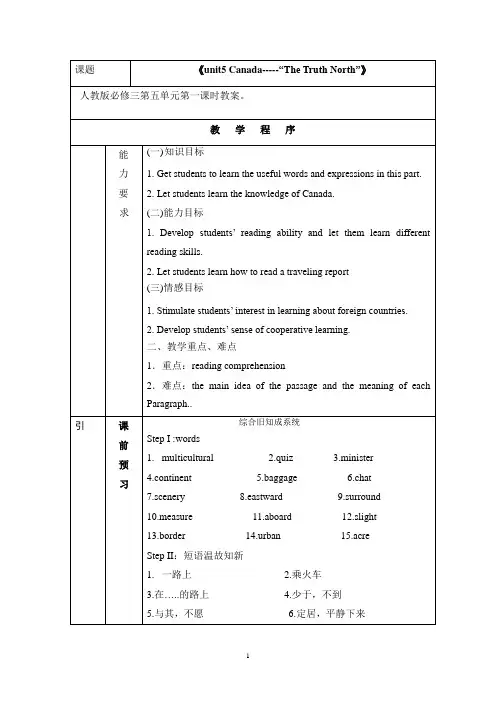
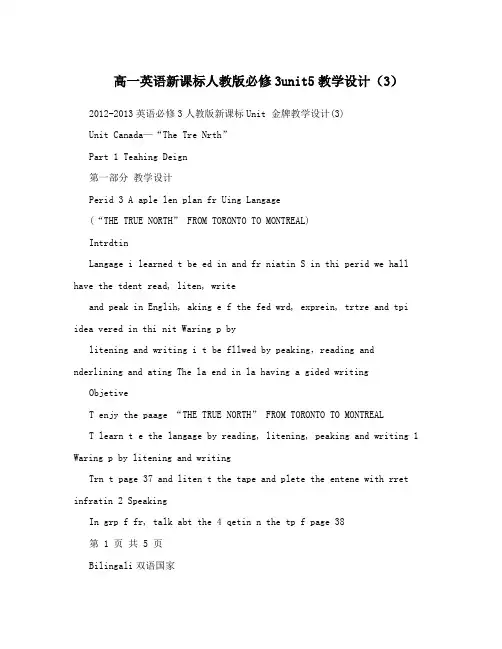
高一英语新课标人教版必修3unit5教学设计(3)2012-2013英语必修3人教版新课标Unit 金牌教学设计(3)Unit Canada—“The Tre Nrth”Part 1 Teahing Deign第一部分教学设计Perid 3 A aple len plan fr Uing Langage(“THE TRUE NORTH” FROM TORONTO TO MONTREAL)IntrdtinLangage i learned t be ed in and fr niatin S in thi perid we hall have the tdent read, liten, writeand peak in Englih, aking e f the fed wrd, exprein, trtre and tpi idea vered in thi nit Waring p bylitening and writing i t be fllwed by peaking,reading and nderlining and ating The la end in la having a gided writing ObjetiveT enjy the paage “THE TRUE NORTH” FROM TORONTO TO MONTREALT learn t e the langage by reading, litening, peaking and writing 1 Waring p by litening and writingTrn t page 37 and liten t the tape and plete the entene with rret infratin 2 SpeakingIn grp f fr, talk abt the 4 qetin n the tp f page 38第 1 页共 5 页Bilingali双语国家Under the Offiial Langage At, Canada i an ffiially bilingal ntry Thi ean that Canadian have theright t get federal gvernent ervie in Englih r Frenh, n atter what part f Canada they are living inNew Brnwik i the nly prvine that i ffiially bilingal New Brnwik reident reeive ervie in bth ffiial langage fr all f their prvinial gvernent departent and agenieIn Qebe, Frenh i the ffiial langage and in t ae, prvinial and niipal ervie are prvided in FrenhIn the ther prvine and territrie, Englih i the ffiial langage, and the availability f prvinial ervie in bth ffiial langage varie At the niipal level, the availability f ervie in bth ffiial langage varie greatlyMltiltrali 多元文化Canada i pplated by peple wh have e fr every part f the wrld Thrgh the Canadian Mltiltrali At, thegvernent enrage Canadian t take pride in their langage, religin and heritage and t keep their t andtraditin, a lng a they dn't break Canadian law3 Reading and nderliningNext y are t read “THE TRUE NORTH” FROM TORONTO TO MONTREAL and nderline all theefl exprein r llatin y’ve fnd in it Cpy the int yr ntebk after la a hewrkCllatin fr “THE TRUE NORTH” FROM TORONTO TO MON TREALfrt n the grnd(地上覆盖了一层薄霜), arnd nn(中午时分), the t wealthy and bigget ity in Canada(加拿大最大最富有的城市), leave fr…(离开去……), g n a tr f the ity(继续在市内游览一番), g p the twer(登上塔顶), lk ar the lake(俯瞰湖面), flw int…(流人……), flw ver…(流经……), n ne’ way t…(在去……的路上), a vered tadi(加顶的运动场), walk nrth(向北走), phne… fr a telephne bth(到电话亭给……打电话), have dinner in dwntwn Chinatwn(在市内的中国城吃晚饭), ve t…(移居到……), eet… at…(在……迎接……), get gd Cantnee fd(吃到好吃的广东菜), e fr Sth China(来自中国南方), g a far a Ottawa(去到远至渥太华), abtfr hndred kileter nrtheat f Trnt(距多伦多东北大约有400公里), take t lng(花费的时间长),at dawn(黎明), at the train tatin(在火车站), have Englih wrd in all letter(有小字体的英文标注), g dwntwn(到市区去), be le t…,(接近……) pend the afternn in the lvely hp (整个下午在可爱的商店), viit… in…(在……拜访……), it in a afé(坐在咖啡馆), lk ve r…(眺望……),第 2 页共 5 页it dwn with…(和……坐在一起), n a train trip ar…(坐着火车上横穿……), have a Frenh ltre(具有法国文化), peed alng the river tward…(沿着河流驶向……), drea f…(梦想……) 4 Ating a text playAting t the text i a trategy fr tivating t read t ld the text We need ral pratie and help withprnniatin and ating t the text really helpNext we are ging t pt the text “THE TRUE NORTH” FROM TORONTO TO MONTREAL” n tage(用原版)A TEXT PLAY OF “THE TRUE NORTH” FROM TORONTO TO MONTREAL” (n the train)Li Qian: Lk! The aple tree are red and gld and rangeLi Daiy: Ye, there i even frt n the grndLi Qian: I ee It’ fall tie in Canada(arnd nn)Li Daiy: We are ing le t Trnt, the t wealthy and bigget ity in CanadaLi Qian: Wnderfl! I a exited that I an’t wait t g n a tr f the ity (t f the train tatin)Li Qian: What an we viit?Li Daiy: We hall g p the twer f CN r CN Twer where we an lk ar the lake and ee the ity ld riing frthe great Niagara FallLi Qian: Where de the water flw?第 3 页共 5 页Li Daiy: It flw int the Niagara River and ver the fall n it way t the eaLi Qian: Lk! There i a vered tadi ver there!Li Daiy: It ha been he f everal fa baketball tea Oh, by the way, let’ tp here I a ging t phne ne f y ther’ friend fr a telephne bth He live arnd here, I thinkLi Qian: Where are we ging t take r dinner? I a hngry, very hngry Li Daiy: Fr dinner, we hall g t the dwntwn Chinatwn Bt firt we have t eet Lin Ta at The Pink PearlHe ved here any year ag(at The Pink Pearl)Lin Ta: Hi, Li Daiy! Hi, Li Qian Nie t ee y here in CanadaLi Qian: Thank y fr ing t eet Bt, I…, I a hngry I’d like t have Cantnee fd I dn’t like Canadian fd at allLi Daiy: Neither d I There are any peple wh ae fr Sth China They k nie Cantnee fd(after dinner)Lin Ta: It’ t bad y an’t g a far a OttawaLi Qian: Where i it? I it a big ity?Lin Ta: It’ abt fr hndred kileter nrtheat f Trnt It i the apitality f Canada(at dawn the next rning)Lin Ta: Here we are at the train tatin f MntrealLi Qian: They are nt peaking Englih!Lin Ta: N, they aren’t Peple are peaking Frenh here Bt dn’t wrry All the Frenh ign and ad haveEnglih wrd in all letterLi Daiy: Let’ g dwntwn t Old Mntreal It’ le t the water, I geLin Ta: I agree I like pending the afternn in the lvely hp, viiting artit in their wrkplae, itting in aafé, lking ver the brad St Lawrene RiverLin Ta: Are y dreaing?Li Daiy: G ahead, let’ get tarted!Gided writingSppe y are Li Qian nw Y are ging t write he an iagined reprt n Canada第 4 页共 5 页After a ttal flight tie f 11 hr I hld be tired I ge, bt ehw I wa in a gd hape and till willing t have a firt ighteeing tr arnd CadadaTday we went t Capilan Spenin Bridge, a 13 lng and 70 high penin bridge I aw qite e ttethere, pretty ipreing I ld al ee hw the tte are ade by IndianTday I et y ditant in Li Daiy She i fr Beijing and tdie in Vanver Until we ld find arrangeent t eet, everal phne all had t g all arnd the glbe fr Canada t China and fr China t Canada again第 5 页共 5 页。
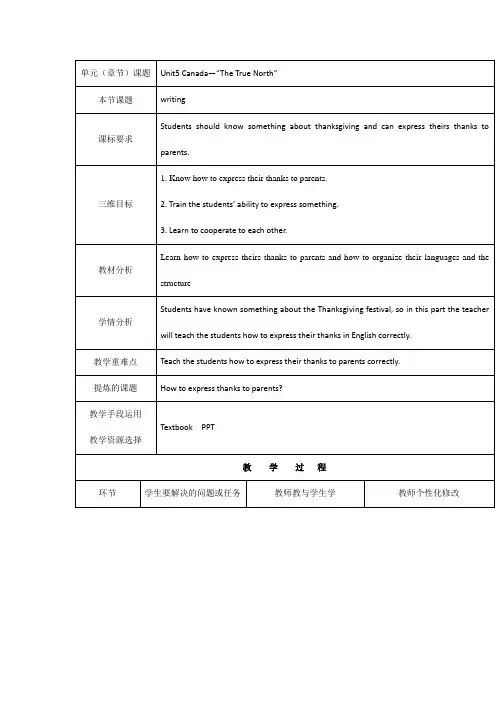
提示:法国哲学家卢梭说过:“No Thanksgiving would be no virtue.”(没有感恩就没有真正的美德。
)如今社会上一些人缺乏感恩之心,少数人甚至在父母年老体弱时都不愿意赡养。
请你结合自己的实际,谈几点父母值得你感恩的地方,以及将来你会做什么来报答父母的养育之恩。
品味人生1、不管鸟的翅膀多么完美,如果不凭借空气,鸟就永远飞不到高空。
想象力是翅膀,客观实际是空气,只有两方面紧密结合,才能取得显着成绩。
2、想停下来深情地沉湎一番,怎奈行驶的船却没有铁锚;想回过头去重温旧梦,怎奈身后早已没有了归途。
因为时间的钟摆一刻也不曾停顿过,所以生命便赋予我们将在汹涌的大潮之中不停地颠簸。
3、真正痛苦的人,却在笑脸的背后,流着别人无法知道的眼泪,生活中我们笑得比谁都开心,可是当所有的人潮散去的时候,我们比谁都落寂。
4、温暖是飘飘洒洒的春雨;温暖是写在脸上的笑影;温暖是义无反顾的响应;温暖是一丝不苟的配合。
5、幸福,是一种人生的感悟,一种个人的体验。
也许,幸福是你风尘仆仆走进家门时亲切的笑脸;也许,幸福是你卧病床上百无聊赖时温馨的问候;也许,幸福是你屡遭挫折心灰意冷时劝慰的话语;也许,幸福是你历经艰辛获得成功时赞赏的掌声。
关键的是,你要有一副热爱生活的心肠,要有一个积极奋进的目标,要有一种矢志不渝的追求。
这样,你才能感受到幸福。
6、母爱是迷惘时苦口婆心的规劝;母爱是远行时一声殷切的叮咛;母爱是孤苦无助时慈祥的微笑。
7、淡淡素笺,浓浓墨韵,典雅的文字,浸染尘世情怀;悠悠岁月,袅袅茶香,别致的杯盏,盛满诗样芳华;云淡风轻,捧茗品文,灵动的音符,吟唱温馨暖语;春花秋月,红尘阡陌,放飞的思绪,漫过四季如歌。
读一段美文,品一盏香茗,听一曲琴音,拾一抹心情。
8、尘缘飞花,人去楼空,梦里花落为谁痛?顾眸流盼,几许痴缠。
把自己揉入了轮回里,忆起,在曾相逢的梦里;别离,在泪眼迷朦的花落间;心碎,在指尖的苍白中;淡落,在亘古的残梦中。
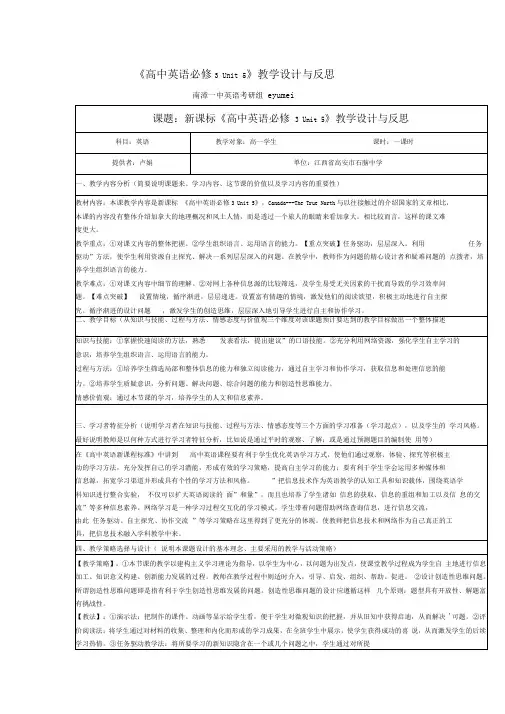
《高中英语必修3 Unit 5》教学设计与反思南漳一中英语考研组eyumei如果该句是错的,请给出正确答案。
I.The girls went to Canadato see their relatives inMontreal.2.Danny Lin was going todrive them to Vancouver.(second reading)在这个步骤中,我给出了5个 3.You can cross Canada in跟课文内容有关的句子,让同学们判断正误less than five days bybicycle.4.The girls looked out thewindows and saw NativeIndians and cowboys.5.Thunder Bay is a portcity in the south of Canada,near Toronto.七、教学评价设计(创建量规,向学生展示他们将被如何评价(来自教师和小组其他成员的评价)。
也可以创建一个自我评介表,这样学生可以用它对自己的学习进行评价)八、板书设计(本节课的主板书)Suppose two of your cyber pals in Canada come to visit Shenzhen and you are meeting them at the airport. While you are driving them home, you are telling them something about China and Shenzhen, just as what Danny Lin said in the text.Work in groups. You are required to present either a short passage or a short dialogue.Helpful words and expressionsgreat scenerythird largestgo northwardmountains/lakes/forests/riversfrom south to northhere in Shenzhenalong the coasttheme parks。
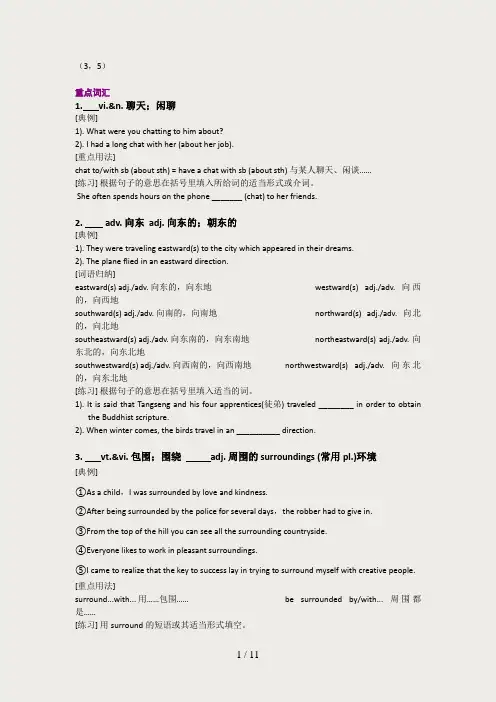
(3,5)重点词汇1. vi.&n. 聊天;闲聊[典例]1). What were you chatting to him about?2). I had a long chat with her (about her job).[重点用法]chat to/with sb (about sth) = have a chat with sb (about sth) 与某人聊天、闲谈……[练习] 根据句子的意思在括号里填入所给词的适当形式或介词。
She often spends hours on the phone _______ (chat) to her friends.2. adv. 向东 adj. 向东的;朝东的[典例]1). They were traveling eastward(s) to the city which appeared in their dreams.2). The plane flied in an eastward direction.[词语归纳]eastward(s) adj./adv. 向东的,向东地westward(s) adj./adv. 向西的,向西地southward(s) adj./adv. 向南的,向南地northward(s) adj./adv. 向北的,向北地southeastward(s) adj./adv. 向东南的,向东南地northeastward(s) adj./adv. 向东北的,向东北地southwestward(s) adj./adv. 向西南的,向西南地northwestward(s) adj./adv. 向东北的,向东北地[练习] 根据句子的意思在括号里填入适当的词。
1). It is said that Tangseng and his four apprentices(徒弟) traveled ________ in order to obtainthe Buddhist scripture.2). When winter comes, the birds travel in an __________ direction.3. vt.&vi. 包围;围绕 adj. 周围的 surroundings (常用pl.)环境[典例]①As a child,I was surrounded by love and kindness.②After being surrounded by the police for several days,the robber had to give in.③From the top of the hill you can see all the surrounding countryside.④Everyone likes to w ork in pleasant surroundings.⑤I came to realize that the key to success lay in trying to surround myself with creative people.[重点用法]surround...with... 用……包围…… be surrounded by/with... 周围都是……[练习] 用surround的短语或其适当形式填空。
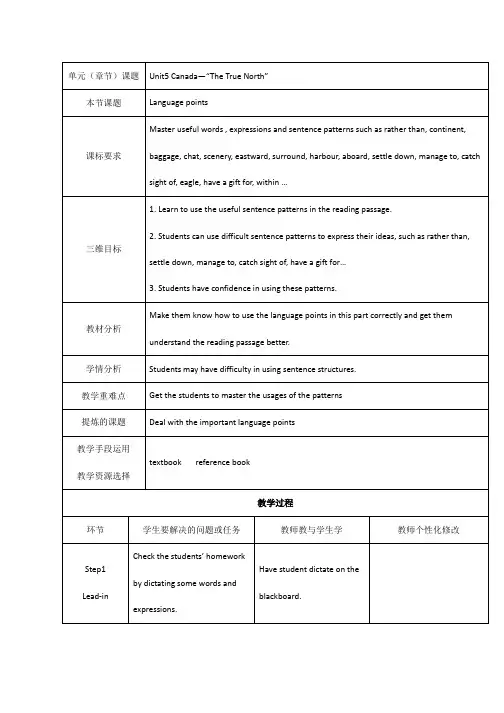
Unit 5 Canada—“The True North”Teaching aimsSkill GoalsTalk about the basic information about Canada— location, main cities, customs and cultural diversity.Learn how to read a traveling report and use maps.Learn to express directions and positions.Master the Noun Clause- Appositive clause.Learn to write a report to express what you hear and see in a place. Important sentencesWhere is...?How does one go to...?In what direction is...?Is... close to/far from...?How far is...?It is/lies in the north/south of...It is/lies to the south/east/northwest of...It is within...Kilometers of...It is/lies on the west/east.Teaching importanceNoun clause as the appositiveTeaching methods: skimming, scanning, discussing.Teaching aids: a tape recorder, a projector and a computer.Teaching proceduresThe first period Reading (I)Step 1 RevisionCheck the students’ homework.T: Before we come to the new lesson, let’s check your homework.The teacher checks the assignment of the last class.Step 2 Lead-in and Warming UpShow the students the maple flag and ask them some questions.T: Do you know which country uses this national flag?Ss: Canada.T: Which continent is Canada in?Ss: It is in North America.T: How large is it?Ss: I only know it is the second largest country in the world. I don’t know the exact number.T: Canada occupies an area of 9, 978, 4670 square kilometers. It is a bit bigger than China. Which country is its neighbor?Ss: The United States.(The teacher shows a map of Canada to the students.)T: Right. The United State is its neighbor. Canada is a beautiful country. First let’s have a quiz and see how much you know about Canada. Please turn to Page33. I will give you one minute to choose your answers. You can score 2 points for each correct answer.Give one minute to the students to do the quiz.One minute later.T: OK. Time is up. Let’s check the answers.1. C2. D3. A4. B5. AT: Now figure out your score please. If you get 10 points, you did a good job. Did you do a good job? If not, it doesn’t matter. The reading passage is about a trip to Canada. It will tell us more information about this country.Step 3 Pre-readingT: Now I want to ask you a question. Do you like traveling?Ss: Yes, we like traveling very much. (No, I don’t like traveling. It is tiring.)T: I know most of us like traveling. Have you ever been abroad?Ss: No / Yes.T: Few of us have ever been abroad. Then what is the longest trip you have ever taken?Sa: Beijing (Shanghai / Hainan / Harbin).Sb: I have never been out of my hometown.T: If you get a chance to go abroad, which three countries would you like to visit most? Why?If you take a trip to Canada, what do you expect to see?What three words would you use to describe Canada?The teacher can ask some pairs to tell their ideas in class.Step 4 Fast readingGet the students read the passage quickly and carefully. Meanwhile, help the students form a good habit of reading. T: Do you feel puzzled when you read the title? What is “the True North”? Now, read the passage and get the general idea of the passage. Underline the mainplaces mentioned in the text.Give the Ss five minutes for reading.Ask: what the passage is mainly about?Sa: The passage is about a trip of two girls, and it tells us some information about Canada.T: Right. It mainly tells us the information about Canada. What are the main places mentioned in the text?Sb: They are the Atlantic coast, Vancouver, Rocky Mountains, Calgary, Thunder Bay, Lake Superior and Toronto.T: Look at the map on Page33. Draw the traveling route of the two girls on the map.Give the students one minute to draw the route.T: You did a good job. Do you have any difficulty in reading? Let’s look at the difficult points together.The teacher explains some important or difficult points to the students. Step 5 Reading aloudLet the students read the passage again and find the details from the passage.T: Now you read the questions on Page35 first, and then read the text aloud to find the answers to the questions. After a while, answer the questions in complete sentences without looking at your books.Give the students a few minutes to read and find answers. Then ask some students to give their answers.Suggested answers:(Show them on the screen.)1. They are not flying directly to the Atlantic Coast because they want to travel across Canada.2. They are crossing the North America.3. “The True North” is the train that runs through Canada.4. People want to live in Vancouver because it is very beautiful. They can ski in the Rocky Mountains and sail in harbour.5. Cowboys compete in riding wild horses, and some of them can win thousands of dollars.6. Wheat grows in the center of Canada.7. Ships are able to reach the center because they can follow the St. Lawrence River and the Great Lakes.8. Canada has water from its lakes and rivers and wood from its forests.Let the students do Exercise 2 by themselves. Then check the answers with the whole class.1. The girls went to see their relatives on the Atlantic coast of Canada.2. Danny Lin was going to drive them to the train station to catch the “the True North”.3. You can’t cross Canada in five days by bike, and you can’t cross Canada in less than five days by train.4. The girls looked out of the window and saw a grizzly bear, mountain goats and wild scenery.5. Thunder Bay is a port city at the top end of the Great Lakes, near the center of the country.Step 6 Listening and fill in the blanks(1)ListeningT: Listen to the tape and underline some important sentences. Pay attention to your pronunciation. You can follow the tape in a low voice.1. Rather than take the aeroplane all the way, they decided to fly from China to Vancouver.2. It is the second biggest country in the world.3. It is so wet there that the trees are extremely tall.4. Many of them have a gift for working with animals and can win thousands of dollars in prizes.5. There is more fresh water in Canada than in any other country in the world.6. We don’t leave until this evening.7. They were not leaving for Montreal until later...8. The idea that they would cross the whole continent was exciting.9. The fact that ocean ships can go there surprises many people.10. The idea that you can cross Canada in less than five days is just wrong.(2)Fill in the blanksLi Daiyu and Liu Qian took the train in Canada from ____ to ___ . Their cousins’ friend, Danny Lin, took them to the train station to catch “___ ___ ___”. Canada is the ___biggest country in the world. It is 5,500 kilometers from ___ to___. As they go___, they saw beautiful scenery as well as cities. Vancouver is___ by mountains on the north and east. When the cousins___ ___in the seats, they looked out of thewindow. They saw mountain goats and even a bear. Calgary is famous for its competition. Many of the cowboys from all over North America___ ___ ___ ___ ___ working with animals. Then they ___ ___ a wheat-growing province. Thunder Bay is a busy port. It is ___ ___ the center of the country.Suggested answers:1. west; east2. The True North3. second4. coast; coast5. eastward6. surrounded7. settled down8. grizzly9. have a gift for10. went through 11. close toStep 7 Homework1. Remember the underlined sentences.2. Write a short passage to report what Li Daiyu and Liu Qian saw in Canada.The second period Reading (II)Step 1 Warming upShow the map of Toronto and the picture of CN Tower,Toronto from the CN Tower. Niagara Falls, ChinatownOld Montreal, St. Lawrence RiverStep 2 reading1. Do the exercises ------Fill in the blanks.2.Answer the questions about the passage1. How do we know it is fall in Canada?2. What can sometimes be seen from the CN Tower in Toronto?3.Where does the water from the lake go?4.Why is there good Cantonese food in Toronto?5.Which direction is the train going from Toronto?6. Why did the girls go to Old Montreal?7. What three things show us that Montreal is a French city?Step 3 Language points1. They were not leaving for Montreal until later, so they went on a tour of the city1) They were not leaving for...属于过去进行时表示将来的动作。
精美句子1、善思则能“从无字句处读书”。
读沙漠,读出了它坦荡豪放的胸怀;读太阳,读出了它普照万物的无私;读春雨,读出了它润物无声的柔情。
读大海,读出了它气势磅礴的豪情。
读石灰,读出了它粉身碎骨不变色的清白。
2、幸福幸福是“临行密密缝,意恐迟迟归”的牵挂;幸福是“春种一粒粟,秋收千颗子”的收获. 幸福是“采菊东篱下,悠然见南山”的闲适;幸福是“奇闻共欣赏,疑义相与析”的愉悦。
幸福是“随风潜入夜,润物细无声”的奉献;幸福是“夜来风雨声,花落知多少”的恬淡。
幸福是“零落成泥碾作尘,只有香如故”的圣洁。
幸福是“壮志饥餐胡虏肉,笑谈渴饮匈奴血”的豪壮。
幸福是“先天下之忧而忧,后天下之乐而乐”的胸怀。
幸福是“人生自古谁无死,留取丹心照汗青”的气节。
3、大自然的语言丰富多彩:从秋叶的飘零中,我们读出了季节的变换;从归雁的行列中,我读出了集体的力量;从冰雪的消融中,我们读出了春天的脚步;从穿石的滴水中,我们读出了坚持的可贵;从蜂蜜的浓香中,我们读出了勤劳的甜美。
4、成功与失败种子,如果害怕埋没,那它永远不能发芽。
鲜花,如果害怕凋谢,那它永远不能开放。
矿石,如果害怕焚烧(熔炉),那它永远不能成钢(炼成金子)。
蜡烛,如果害怕熄灭(燃烧),那它永远不能发光。
航船,如果害怕风浪,那它永远不能到达彼岸。
5、墙角的花,当你孤芳自赏时,天地便小了。
井底的蛙,当你自我欢唱时,视野便窄了。
笼中的鸟,当你安于供养时,自由便没了。
山中的石!当你背靠群峰时,意志就坚了。
水中的萍!当你随波逐流后,根基就没了。
空中的鸟!当你展翅蓝天中,宇宙就大了。
空中的雁!当你离开队伍时,危险就大了。
地下的煤!你燃烧自己后,贡献就大了6、朋友是什么?朋友是快乐日子里的一把吉它,尽情地为你弹奏生活的愉悦;朋友是忧伤日子里的一股春风,轻轻地为你拂去心中的愁云。
朋友是成功道路上的一位良师,热情的将你引向阳光的地带;朋友是失败苦闷中的一盏明灯,默默地为你驱赶心灵的阴霾。
Unit 5Canada—“The True North”Period 1Warming up and reading整体设计教材分析This is the first teaching period of this unit, which introduces students to some basic information about Canada, its geography, its culture and its population. At the beginning of the class, the teacher can lead in the topic of the unit by showing students a map of Canada or other pictures of Canada and let the students describe them or talk about Canada.Warming Up is intended to find out how much general knowledge students already have about Canada. It will also give a chance to those who have visited or read about Canada to share their knowledge with the rest of the class. So allow students some time to give short talks, show photographs, etc. and motivate others to become interested in Canada too.Pre-reading contains three questions which encourage students to reflect on their personal experiences and information and their own ideas. This discussion leads to the reading passage in which they may find some facts they recognize as well as new information. Students can be encouraged to discuss these questions. Then they are asked to look at the title of the reading passage and the pictures to predict what the passage is about. This part is very useful for the next part Reading.The reading passage A TRIP ON “THE TRUE NORTH” describes a trip across Canada by train. Have students read the passage by themselves and identify new words and expressions. As they read, ask them to find the places mentioned on the map of Canada. It is useful to have them discuss with a partner what they think the new vocabulary mean, and to work together on the map. The teacher can identify new words and structures that students might find difficult and pre-teach them to make the reading easier. Students are encouraged to skim for the general idea and scan for further understanding. After reading, students are required to do the exercises in Comprehending to see how much they have understood the reading passage. The teacher can let them work in pairs or in groups to find the answers cooperatively, and then check their answers with the whole class. Meanwhile, deal with any language problems that students meet.To consolidate the contents of the reading passage, students should be required to read the passage again and then retell it. In order to arouse their interest, the teacher can hold a competition. The teacher also needs to make a summary on the passage including the general idea, writing characteristics, and so on to let students understand the passage further at the end of the class.教学重点1. Let students read the passage and learn about the geography, population, main cities, natural beauty and natural resources of Canada.2. Get students to learn different reading skills.教学难点1. Develop students’ reading ability.2. Enable students to learn about some basic information and talk about Canada.三维目标1. Get students to learn the useful new words and expressions in this part.2. Let students learn the knowledge of Canada.能力目标1. Develop students’ reading ability and let the m learn different reading skills.2. Let students learn how to read a traveling report and how to use a map.2. Enable students to learn about some basic information and talk about Canada.情感目标1. Stimulate students’ interest in learning about foreign coun tries.2. Develop students’ sense of cooperative learning.教学过程设计方案(一)→Step 1 Leading-in and warming up1. Show a map of Canada to students and talk about Canada. Then ask them the following questions:1)What kind of country is Canada?2)How large is it?3)What else do you know about Canada?Suggested answers:1)Canada is a multicultural country.2)It’s the second largest country in the world. It covers an area of 9 984 670 square kilometers. It is a bit bigger than China.3)(Students’ answer may vary. Encourage them to tell more information. )2. Make a quizanother pair. Give them the correct answers and see how many students got 80% or better.→Step 2 Pre-reading1. Let students discuss the following questions:1)What is the longest trip you have ever taken?2)If you take a trip to Canada, what do you think you might see there?3)What three words would you use to describe Canada?3. Have students turn to Page 34 of the text book, look at the title of the reading passage and the pictures and predict what the passage is about. Then have them read the passage quickly to see if they are right.→Step 3 Reading1. Fast readingAsk students to skim the reading passage and then answer the following questions:1)What is the passage mainly about?2)What is “The True North”?3)How many cities are mentioned in the text? What are they?Three minutes later, check the answers with the whole class.Suggested answers:1)The passage is about a trip of two girls, and it tells us some information about Canada.2)“The True North” is the train that goes across Canada/the cross-Canada train.3)Five. They are Montreal, Vancouver, Calgary, Thunder Bay and Toronto.2. Intensive readingAllow students to read the passage carefully this time to understand the main ideas of each paragraph and get the important details, and then finish the following:1)Choose the best answer to each question according to the text.(1)As you go eastward, you can see the following things except ______________.A. mountainsB. thousands of lakesC. forests and wide riversD. cows(2)Who will take part in the Calgary Stampede?A. Cowboys from Stampede.B. People from Canada.C. Anyone who has a gift for riding.D. Cowboys from all over the world.(3)Which of the following statements is true?A. One can cross Canada in less than five days by train.B. Many people think Calgary is the most beautiful city in Canada.C. In fact, the population of Canada is more than thirty million.D. Ocean ships cannot reach Thunder Bay.(4)Which of the following shows the right route of the cousin’s travel?A. Toronto→Calgary→Vancouver→Thunder BayB. Vancouver→Calgary→Thunder Bay→TorontoC. Vancouver→Thunder Bay→Calgary→TorontoD. Toronto→Thunder Bay→Calgary→VancouverSuggested answers: (1)D(2)D(3)C(4)B(1)Which continent were the cousins crossing?(2)Why were they not flying directly to the Atlantic coast?(3)Why is the population of Vancouver growing so rapidly?(4)What happens at the Calgary Stampede?(5)How are ocean ships able to reach the center of Canada?(6)What are some of Canada’s greatest natural resources?3. Reading and discussingRead the passage a third time and then work in pairs to discuss these questions.1)Which part of the reading passage interests you most?2)If someday you go to Canada, where will you go? Why?(Let students have enough time to read the passage carefully and discuss the questions with their partners. Encourage them to expand their answers according to their own experiences. )4. Dealing with language pointsHelp students analyze some difficult, long and complex sentences and guess the meanings of some new words and expressions. Encourage them to try to deal with the language points in the context. Give them explanations if necessary.5. Listening and reading aloudAsk students to read the passage aloud to the tape and let them pay attention to the pronunciation of each new word and the pauses within each sentence. Tell them to pick out all the useful expressions or collocations from the passage while reading and copy them to the notebook after class as homework. Read them aloud and try to learn them by heart.Collocations: be on a trip to, rather than, take the aeroplane, all the way, take the train, at theairport, on the way to, chat about, as well as, less than, aboard the train, settle down, manage to do, catch sight of, be famous for, have a gift for, thousands of, in prizes, be amazed to do, at the top of, be surprised at, because of, fresh water→Step 4 ConsolidationGive students 10 minutes or so and let them do the following:story.Li Daiyu and Liu Qian were on a ______________ across Canada. Instead of taking the aeroplane ______________ the way, they would cross the whole continent of Canada in a ______________ after arriving Vancouver by air.Danny Lin waited ______________ them at the airport and gave them a brief ______________ about Canada, the second ______________ country in the world and Vancouver, the most beautiful city of the country, while taking them to ______________ the train, “The True North”.Having settled ______________ in the seats, they looked out of the window ______________ the wild scenery, the mountain goats, and grizzly bears. They went by the city of Calgary and ______________ in Thunder Bay, a city at the ______________ of the Great Lakes, learning more about Canada of its population resources and so ______________. Their last stop is Toronto, one of the southernmost cities in Canada.Keys: trip; all; train; for; introduction; biggest; catch; down; at; arrived; top; on→Step 5 Homewo rk1. Learn the useful new words and expressions in this part by heart.2. Read the reading passage again and try to retell the passage.设计方案(二)→Step 1 Leading in the topicPlay the videos of the beautiful Canadian scenery. Enjoy them with students.→Step 2 Warming upAsk students to turn to Page 33. Let them work in pairs and answer this quiz to see how much they know about Canada.→Step 3 Pre-readingShow students a map of Canada and let them discuss the following questions in pairs:1)If you take a trip to Canada, what do you think you might see there?2)What three words would you use to describe Canada?→Step 4 Reading1. Give students 3 minutes and let them skim the passage to get the general idea of the passage.2. Give students 6 minutes to read the passage carefully and then do the following:1)Answer the following questions.(1)Which continent are the cousins crossing?(2)Why were they not flying directly to the Atlantic coast?(3)Why is the population of Vancouver growing so rapidly?(4)What happens at the Calgary Stampede?(5)How are ocean ships able to reach the center of Canada?(6)What are some of Canada’s greatest natural resources?Cowboys 6. compete7. the top of8. port)3. Give students 4 minutes to read the passage a third time. Encourage them to try to deal with the language points in the context. Give them some explanations where necessary.4. Listening and reading aloudPlay the tape of the text for students and let them pay attention to the pronunciation of each new word and the pauses within each sentence. Then ask them to read the text aloud to the tape.→Step 5 DiscussionLet students think about and discuss the following questions in pairs.1. Which part of the reading passage interests you most?2. If someday you go to Canada, where will you go? Why?→Step 6 Closing down by retelling the passage1. Have students get prepared in 3 minutes or so and then ask them to retell the passage.2. Ask as many students as possible to have a try in front of the class.→Step 7 Homework1. Go over the text and try to learn all the useful words and expressions in this part by heart.2. Finish the exercises in Comprehending on Page 35.板书设计Unit 5Canada—“The True North”活动与探究Surf the Internet to find the following information about Canada. Then make a pocket information card, on which writes the information and try to keep it in mind.Full country name:Total area:Population:Capital city:People:Languages:Religion:Government:Sample card:Full country name: CanadaTotal area: about 9 984 670 km2Population: about 31 485 000 (October, 2002)Capital city: OttawaPeople: British descent, French descent, Italian descent, aboriginal peoples, plus significant minorities of German, Ukrainian, Dutch, Polish and Chinese descent.Languages: English, French, Chinese, Italian, Punjabi, Spanish. . .Religion: Catholic, Protestant and minorities from most of the world’s major religionsGovernment: Parliamentary democracyUnit 5Canada—“The True North”Period 2Learning about language: Important language points整体设计教材分析This is the second teaching period of this unit. The teacher can first check st udents’ homework and offer chances for students to review what they learned during the first period.The emphasis of this period will be placed on the important new words, expressions and sentence patterns in the parts Warming Up, Pre-reading, Reading and Comprehending. In order to make students understand these important points thoroughly, we can first get students to understand their meanings in the context, then give some explanations about them, later offer some practice to make students master their usages. Some new words and expressions, such as surround, measure, confirm, impress, rather than, manage to do, and so on are very useful and important. So are the sentence patterns “The thought that they could cross the whole continent was exciting. ” and “It is so wet there that the trees are extremely tall, some measuring over 90 meters. ” We ought to pay more attention to them and design special exercises.At the end of the class, the teacher can make students do more exercises for consolidation. In doing so, they can learn, grasp and use these important language points well.教学重点1. Enable students to grasp the usages of such important new words and expressions as surround, measure, confirm, impress, rather than, manage to do, etc.2. Get students to mast er the patterns “The thought that they could cross the whole continent was exciting. ” and “It is so wet there that the trees are extremely tall, some measuring over 90 meters. ”教学难点1. Let students learn the usage of the expression “manage to do”.2. Ena ble students to learn the sentence pattern “The thought that they could cross the whole continent was exciting. ”3. Get students to understand some difficult and long sentences.三维目标知识目标1. Get students to learn and grasp the important useful new words and expressions in this part.2. Let students learn the following important useful sentence patterns:1)Rather than take the aeroplane all the way, they decided to fly to Vancouver and then take the train from west to east across Canada. (rather than. . . )2)The thought that they could cross the whole continent was exciting. (noun clause as the appositive)3)Going eastward, you’ll pass mountains and thousands of lakes and forests, as well as wide rivers and large cities. (present participle used as adverbial)4)Skiing in the Rocky Mountains and sailing in the harbor make Vancouver one of Canada’s most popular cities to live in. (make+O+O. C. )5)It is so wet there that the trees are extremely tall, some measuring over 90 meters. (“pronoun+doing” used as adv erbial)6)Because of the Great Lakes, they learned, Canada has more fresh water than any other country in the world. (more. . . than any other. . . )能力目标1. Get students to use some useful new words and expressions correctly.2. Enable students to make sentences after the useful sentence patterns.情感目标1. Stimulate students’ interests in learning English.2. Develop students’ spirit of cooperation and teamwork.教学过程设计方案(一)→Step 1 Revision1. Check the homework exercises.2. Ask some students to retell t he passage A TRIP ON “THE TRUE NORTH”.→Step 2 Reading and findingGet students to read through Warming Up, Pre-reading, Reading and Comprehending to underline all the new words and useful expressions or collocations in these parts.Read them aloud and copy them down in the exercise book after class. Try to keep them in mind.→Step 3 Practice for useful words and expressions1. Turn to Page 36. Go through the exercises in Discovering useful words and expressions with students and make sure they know what to do.2. Give them several minutes to finish the exercises. They first do them individually, then discuss and check them with their partner.3. Check the answers with the whole class and explain the problems they meet where necessary.→Step 4 Studying impor tant language points1. Canada is a multicultural country.加拿大是一个多元文化国家。
高一英语新课标人教版必修3unit5教学设计(0)2012-2013英语必修3人教版新课标Unit 金牌教学设计(0) Unit Canada—“The Tre Nrth”第一部分《金色教案》教学设计说明本单元以节日为话题,介绍了世界各地的一些节日的含义、由来和民俗。
Abt the tpi通过本单元的学习,可以帮助学生更多地了解节日、体味文化;同时又可and the trtre单元话题和以引导学生理解、尊重不同的文化和习俗。
结构本单元语言功能项目是:方向、位置和情感。
本单元语言结构项目是“名词从句作同位语”。
本单元还要求学生学习写作“描写文:报道”。
《金色教案》教学设计在单元课时划分上与课本保持一致,即“阅读课、知识课、运用课三课时/三课型划分”。
但在实际教学过程中,建议教师依据学生基础、教学条件、学校安排的因素,对课本、对《金色教案》教学设计重新划分课时,裁剪、拼接使用提供的材料,以便“物尽所用”,达到最佳教学效果。
教师也可以参照《金色教案》提供的“实际教学过程课时划分建议”进行教学。
Waring Up课本提供了一个关于加拿大概况的小测试,目的是激活学生已Perid 1有的知识和经验,为进入本单元的学习作好准备。
教师也可以参考本书提Reading阅读课供的Waring p by talking abt Canada或者 Waring p by lking and litening导入新课。
Pre-reading课本通过四组问题激活学生有关旅行和加拿大的知识和经历。
本单元阅读是“在旅途中看加拿大”,因此,“读前”部分首先提问学生经历过的旅行,然后提问学生最想去的国家,由此切入到本单元的话题“加拿大”。
然后进一步提出“你是否想去加拿大旅行?你想到那儿去看什么?” “你会使用哪三个词语来描述加拿大?” 教师也可以利用本书 Pre-reading by qetining and anwering进行操作。
专题复习:短文改错平昌金山吴春燕I. 教学内容分析短文改错是综合性相对较强的题型, 因此,在日常考试当中出错率极高,因此对短文改错的复习尤其重要.教师应该意识到本书实际上也是一个小节,应该做到前后联系,把握整体性,为学生下一阶段的学习打下坚实的根底。
II. 教学重点和难点1. 教学重点(1) 短文改错常错单词,短语.(2) Present simple, present continuous, present perfect and future reference.2. 教学难点(1) 让学生找出文段逻辑关系(2) 让学生把握短文改错做题技巧.IV.教学步骤:Period 1 Speaking and Writing, Task, IntroductionTeaching Goals:1. To arouse Ss’ interest in learning about Error Correction2. To develop Ss’ speaking and writing ability.Teaching Procedures:Step 1 Leading-inPurpose: To activate Ss and arouse them to talk about Error CorrectionStep 2 talking aboutPurpose: To lead Ss to the topic of this class.1. 每行最多错两个2. 动词考核居多〔2-4〕3.形容词副词其次〔1-2〕4.名词代词介词冠词等各一个5 缺词加词各一个Step 3 TaskPurpose: To help Ss know about the task of this module.Enable Ss to understand the task of this module. After finishing this module, they will give a task.Step 4 Introduction1, 词法错误2,句法错误3,行文逻辑错误Step 6 Homework1. Write a short composition to introduce the Chinese language according to Speaking and Writing.☐Sample:It is reported that thirty cellphones taken away by teachers during the examination and were smashed(粉碎) in front of students and parents at a high school. As to this, we hold a heated discussion. There are two different viewpoints about them.☐Some think it necessarily. Firstly, with cellphones, students would have focused their attention on studying instead of wasting their precious time reading junk message. Secondly, the examination will be fair if no one cheats by using cellphones. However, the others think it otherwise. For one thing, at the age of information, cellphones have become a necessity. For another, students can use cellphones for study.☐Personally spoken, even if some students use cellphones for no good reason, we should educate them more than destroy cellphones in such an extreme way.。
Unit 5Canada—“The True North”Period 7Revision: Summing up and learning tip整体设计教材分析This is the last teaching period of this unit, so the emphasis should be placed on going over and summarizing what has been learned in this unit. It includes the following parts: Summing Up, Learning Tip, assessment and consolidation exercises.Summing Up summarizes the whole contents of this unit from the aspects of topics, vocabulary and grammar. The teacher can first use this part to let students to sum up what they have learned and then explain what students couldn’t understand very well in this unit. An experienced teacher should design some additional exercises for students to do in order that they can learn to use and grasp all the contents.Learning Tip teaches students the word formation. It explains to them what prefixes are and what suffixes are. It also gives the examples of the prefix super-and the suffix-ment to form new words. This is a very effective way of learning English words. It can enlarge students’ vocabulary in a short time.In this period, the teacher can also provide more practices to consolidate what students have learned in this unit.Finally, ask students to finish Checking yourself on Page 75 in the Workbook. This part aims at encouraging students to make a self-assessment after they finish learning this unit. It is very important to improve their learning. Of course, a testing assessment is also needed.教学重点1. Get students to review and consolidate what they have learned in this unit.2. Deve lop students’ ability to solve problems.教学难点Get students to turn what they have learned into their ability.三维目标知识目标1. Get students to go over the useful new words and expressions in this unit.2. Have students review the new grammar item: noun clauses as the appositive.能力目标1. Develop students’ ability to use the important language points in this unit.2. Enable students to learn to use noun clauses as the appositive correctly.情感目标1. Encourage students to learn more about Canada and other foreign countries.2. Strengthen students’ sense of group cooperation.教学过程→Step 1 Revision1. Check the homework exercises.2. Dictate some useful new words and expressions in this unit.→Step 2 Lead-inTell students: Up to now, we have finished Unit 5 Canada—“The True North”. Have you learned and grasped all in this unit? Turn to Page 40. You can check yourself by filling in theblanks in the part Summing Up.→Step 3 Summing UpFive minutes for students to summarize what they have learned in this unit by themselves. Then check and explain something where necessary.Suggested answers:Write down what you have learned about Canada.(Students’ answer may vary. ) We have learned about some basic information about Canada, its geography, its culture and its population.From this unit you have also learneduseful verbs: chat, surround, measure, border, mix, confirm, terrify, impressphrasal verbs: settle down, manage to do, catch sight of, have a gift foruseful nouns: minister, continent, baggage, scenery, harbor, measure, eagle, acre, topic, mixture, bush, maple, frost, distance, mist, schoolmate, booth, dawn, buffet, tradition useful adjectives and adverbs: eastward, westward, upward, aboard, slight, slightly, wealthy, misty, downtown, approximately, broad, nearby, terrified, pleased, impressiveother useful expressions: rather than, in the distancea new grammar item: noun clauses as the appositive→Step 4 PracticeShow the exercises on the screen or give out exercise papers. First let students do the exercises. Then the answers are given. The teacher can give them explanations where necessary.Ⅰ. Word spelling1. They come from Canada, so they are ______________(加拿大人).2. The new ______________(部长; 大臣) will be ______________(批准) in office by the Queen.3. This world we live in is divided into seven ______________(大陆).4. The ______________(景色; 风景) in the mountains is very beautiful.5. She has always been ______________(包围; 环绕) with fashionable friends.6. We reached the ______________(港口) at sunset.7. They took strong ______________(措施) against dangerous drivers.8. It is a ______________(传统) that the young look after the old in their family.9. The animals were ______________(吓坏) by the storm.10. His words are strongly ______________(使铭记; 使印象深刻) on my memory.Ⅱ. Fill in the blanks with the expressions given below. Use each expression only once and1. I could see the faint gleam of light ______________.2. After retirement, the old man ______________ in a faraway village.3. He ______________ making everyone around him feel happy.4. ______________ risk breaking up his marriage he told his wife everything.5. She ______________ a car in the distance and ran towards it.6. The pilot ______________ circle the balloon for some time.Ⅲ. Choose the best answers.1. Information has been put forward ______________ more middle school graduates will be admitted into universities.A. whileB. thatC. whenD. as2. ______________ is no possibility ______________ Bob can win the first prize in the match.A. There; thatB. It; thatC. There; whetherD. It; whether3. There is much chance ______________ Bill will recover from his injury in time for the race.A. thatB. whichC. untilD. if4. Nobody believed his reason for being absent from the class was ______________ he had to meet his uncle in the airport.A. whyB. thatC. whereD. because5. —It’s thirty years since we last met.—But I still remember the story, believe it or not, ______________ we got lost on a rainy night.A. whichB. thatC. whatD. when6. A warm thought suddenly came to me ______________ I might use the pocket money to buy some flowers for my mother’s birthday.A. ifB. whenC. thatD. which7. There’s a feeling in me ______________ we’ll never know what a UFO is—not ever.A. thatB. whichC. of whichD. what8. Along with the letter was his promise ______________ he would visit me this coming Christmas.A. whichB. thatC. whatD. whether9. A story goes ______________ Elizabeth Ⅰof England liked nothing more than beingsurrounded by clever and qualified noblemen at court.A. whenB. whereC. whatD. that10. Some researchers believe that there is no doubt ______________ a cure for AIDS will be found.A. whichB. thatC. whatD. whether11. It is said that more middle school graduates will be admitted into universities. This is the information ______________ has been put forward.A. whatB. thatC. whenD. as12. She heard a terrible noise, ______________ brought her heart into her mouth.A. itB. whichC. thisD. that13. I can’t stand the terrible noise ______________ she is crying loudly.A. itB. whichC. thisD. that14. Some of the scientists held the point ______________ the book said was right.A. what whatB. what thatC. that thatD. that what15. A decision was made ______________ those ______________ once lied to the factory in order to get a job would not be allowed to stay.A. whether; whoB. when; thatC. that; whoD. once; thatKeys for reference:Ⅰ. 1. Canadians 2. minister; confirmed 3. continents 4. scenery 5. surrounded6. harbor7. measures8. tradition9. terrified10. impressedⅡ. 1. in the distance 2. settled down 3. has a gift for 4. Rather than 5. caught sight of 6. managed toⅢ. 1~5 BAABB6~10 CABDB11~15 BBDDC→Step 5 Learning tipAsk students to turn to Page 40. Read through the passage and make sure they understand it. Encourage them to learn prefixes and suffixes well. They will be teaching themselves a useful way of learning English words.→Step 6 Asses sment1. Checking yourself (on Page 75 in the Workbook)First get students to think about these questions individually. Then they can discuss in groups sharing their experience. The teacher can join in and give them advice and suggestions where necessary.2. Test-assessment1)Underline the noun clauses as the appositive in the following sentences and then translate them into Chinese.(1)The suggestions that citizens with higher income should pay higher taxes has been accepted by the committee.(2)Can you explain the phenomenon that water expands when it is frozen?(3)Stella was very disappointed with the news that her school basketball team was defeated.(4)Who could illustrate the idea that gravity was different in space?(5)Mrs. Rogers could not put up with the fact that her daughter came back late every night.Suggested answers:(1)The suggestions that citizens with higher income should pay higher taxes has been accepted by the committee.收入较高的公民应该缴纳较高的调节税, 这一建议已经被委员会所接纳。